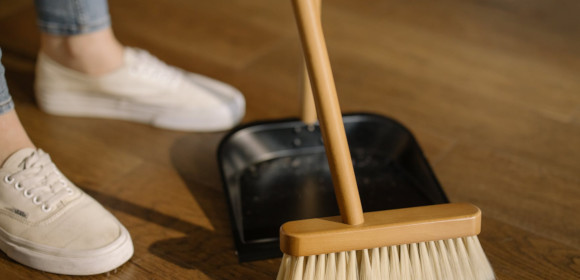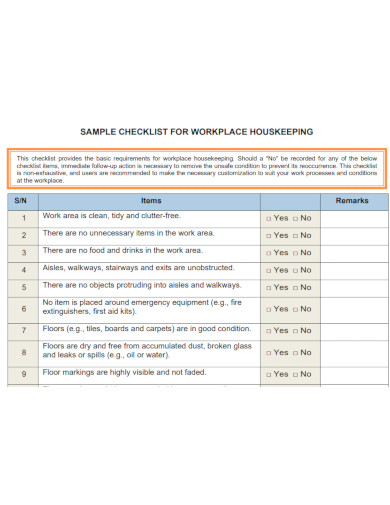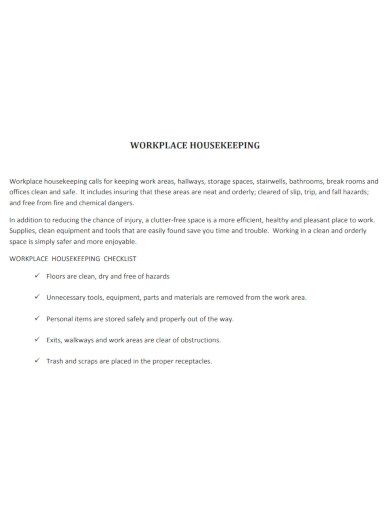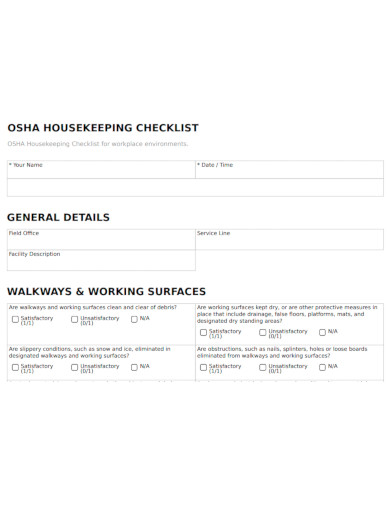Housekeeping in workplaces requires more effort and dedication compared to homes. It doesn’t only limit to cleanliness. In fact, it involves constant equipment, machine, and property maintenance, and, pay attention to the layout of the workplace, make sure the storage facilities are adequate enough for business, and practice fire safety tasks. It is not an easy task for one person to do alone; everyone in the workplace should cooperate to practice effective housekeeping. Effective housekeeping is an ongoing task; it is routine work, not a one-time or hit-and-miss cleanup done once in a blue moon. To help you and your staff keep up with housekeeping, you need a checklist to guide you on the tasks you need to do. Keep reading the article to know how to make a workplace housekeeping checklist.
3+ Workplace Housekeeping Checklist Sample
1. Workplace Housekeeping Checklist Samples
2. Printable Workplace Housekeeping Checklist
3. Workplace Housekeeping Checklist Format
4. Professional Workplace Housekeeping Checklist
Importance of Workplace Housekeeping Checklist
A workplace housekeeping checklist is a tool used by workers to ensure that the workplace is well organized, hygienic, and safe for all employees. Regular workplace housekeeping prevents workplace hazards, boost work productivity, and help the business avoid fines for non-compliance. The checklist can also help effectively plan and manage housekeeping tasks for workers to do regularly to ensure every workspace is clean and organized.
How to Create a Workplace Housekeeping Checklist
1. Take Inventory
First, you need to get a pen and a clipboard or a notebook. Walk around your workplace, room by room, and take a realistic inventory of the areas and tasks that will be included in your housekeeping checklist.
2. List All the Cleaning Tasks That Needs to be Done
Make a list of cleaning tasks to do in every room. Below are some examples of cleaning tasks that you can include in your checklist:
- Spills must be mopped and wiped immediately to avoid slipping
- Aisles, stairways, doors, and walkways need to be cleared of furniture, debris, and other materials that block the way
- Mirrors and warning signs must be installed in blind spot areas
- Any damages to the flooring should be replaced
- Anti-slip flooring or mats should be put in areas that are prone to get wet
- Keep combustible materials away from ignition sources and store them properly
- Keep any materials away around a meter or so from fire extinguishers, and sprinklers
- Vacuum the workplace regularly
- Dust equipment, shelves, furniture, cupboard regularly
- Place heavy objects on lower shelves
- Avoid stacking items near walkways
- Install toe boards or nets to prevent falling objects from hitting workers
- Return any tools and materials in the storage immediately after use
- Wear personal protective equipment (PPE) whenever you’re handling toxic materials or working in hazardous situations and discard the PPE after use
- Don’t use damaged tools, PPEs, or equipment.
3. Make a Schedule
Once you’ve listed all the tasks you have to do, decide how often each workspace will be cleaned. Some rooms need cleaning every day, and some weekly. Categorize each room by providing a schedule on when they will be cleaned.
FAQs
What are the seven standards for housekeeping?
The seven standards or the 7S of good housekeeping consist of sort, systematize, sweep, standardize, safety, self-discipline, and sustain.
What are the signs of poor housekeeping?
If a home or workplace has poor housekeeping, it is very obvious to see with your own bare eyes. The place is cluttered, untidy, dusty, and definitely dirty. There are also possibilities to see blocked aisles and exits and broken furniture and equipment.
What are some benefits of good housekeeping practices?
There are a lot of benefits that you can get from good housekeeping practices. It can help reduce risks of hazardous incidents that could result in accidents or injuries, lowers exposure to hazardous products, equipment is more efficient because of maintenance, improve hygiene conditions that lead to health improvement, reduce property damage, less repair work, and it improves productivity.
Once you’re done creating your checklist, make several copies of it and hand it out to your workers and discuss it with them. Make sure they understand and adhere to cooperate in the housekeeping tasks they need to do by following the checklist. Assign different responsibilities to your employees so everyone has a fair share of housekeeping workload. Stick the checklist in bulletin boards and workspaces to make sure everyone will always remember their tasks. This is especially important for workplaces that have no janitorial staff. If you need a guide to make a checklist, download our free sample templates provided above!
Related Posts
FREE 17+ House Cleaning Flyers Templates
FREE 14+ Sample Checklists
FREE 13+ Sample Daily Checklists
FREE 12+ Sample Housekeeping Resume Templates
FREE 11+ Sample Weekly Checklist Templates
FREE 11+ Weekly Checklist Templates
FREE 10+ Self-Inspection Checklist Samples
FREE 10+ Room Maintenance Checklist Samples
FREE 10+ Room Inspection Checklist Samples
FREE 5+ Housekeeping Evaluation Samples
FREE 19+ Cleaning Proposal Samples
FREE 12+ Office Maintenance Schedule Samples
FREE 10+ Cleaning Price List Samples
FREE 10+ Agreement Checklist Templates
FREE 7+ Sample Housekeeping Resume Templates




